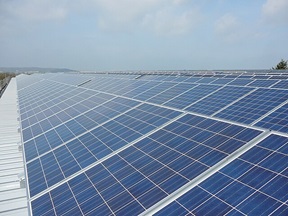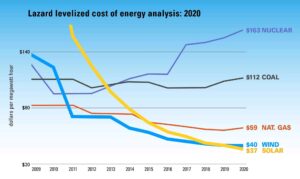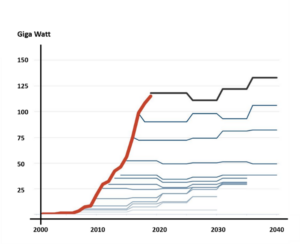After many years of unashamed scepticism, the International Energy Agency finally published a positive report about renewable energy; in their World Energy Outlook 2023. But with a warning: we need to step up in order to restrict global warming to 1.5oC.

A clean economy in the making
Firstly, let’s look at it from the positive side. The World Energy Outlook 2023 welcomes ‘the emergence of a new clean energy economy, led by solar PV and electric vehicles (EVs).’ Showing in the following data.
- Investments in clean energy have risen by 40% since 2020
- Clean energy technologies have strong market positions
- In 2020, one in 25 cars sold was electric; in 2023, this is now one in 5
- More than 500 gigawatts (GW) of renewables generation capacity are set to be added in 2023 – a new record
- More than $ 1 billion a day is being spent on solar deployment
- Manufacturing capacity for key components of a clean energy system, including solar PV modules and EV batteries, is expanding fast
- All in all, the World Energy Outlook 2023 judges that that ‘a pathway to limiting global warming to 1.5oC is very difficult – but remains open.’ To be sure: we already consumed 1.2oC of this 1.5oC space.
A difficult pathway, anyway
But ‘much additional progress is still required to meet the objectives of the Net Zero Emissions by 2050 (NZE) Scenario which limits global warming to 1.5°C.’ Particularly, according to the World Energy Outlook 2023, the share of coal, oil and gas in world energy supply goes down very slowly. At present it is still 80%, in 2023 it will probably still be 73%.

And yet, the future looks much brighter than a while ago, thanks to changes speeding up in many parts of the world. In the United States, the share of electric cars in 2030 will be 50%, whereas two years ago this was predicted be a mere 12%. In the European Union, the sale of heat pumps rises fast. In China, the country where a large share of changes needs to take place, predictions on solar panels and offshore wind turbines are three times those of two years ago.
China plays a dominant role
The role of China in the transition is important. Over the past ten years, most of the increase in fossil fuels use (and CO2 emissions) took place in China. Bu now economic growth has slowed down, particularly in energy intensive sectors like cement and steel. Moreover, China makes a major effort; in 2022 it installed half of new solar panels and wind turbines worldwide. And as its economic growth flattens off, this could help restricting global heating to 1.5oC.
But according to World Energy Outlook 2023, an even bigger task is on the plates of emerging and developing economies. China and the developed countries just have to do better than they did; developing countries need to invest five times as much as they did in the past. That will require more international support. Developing countries need ‘clean electrification, improvements in efficiency and a switch to lower- and zero-carbon fuels’ – quite a task, starting from the present situation.
We still need more effort
Solar panel production needs to be spread over more countries. And of course, not just production technology needs to change. Renewable sources require an infrastructure that is completely different. Countries will have to enlarge and strengthen the grid, and construct new energy storage. We should also invest in technologies for demand response, batteries for short-term flexibility and additional technologies for long-term flexibility. Taken together, these efforts could keep the door open for 1.5oC global heating.
But in the past, IEA took a completely different view
These positive formulations are quite different from IEA’s former position. Until quite recently, they held that new energy technologies would fall far short of expectations. For fifteen years, even down to 2020, the IEA predicted that solar and wind energy would no longer grow. But they did – each consecutive year, growth remained high. 2020 was even a record year for renewable energy. The world added a whopping 45%, compared to 2019. And at last, IEA added 25% to its forecasts.

Part of the story is that in their World Energy Outlook, IEA always overestimated capital costs of solar and wind energy; the most important cost factor. But then they ‘discovered’ that countries supported renewable energy sources; particularly by reducing the risk of investments. Finally, they acknowledged this support in their projected prices. Suddenly then, solar energy appeared to be the cheapest source of electricity.
A new question
Now, solar prices have come down so far that this is no longer disputed. According to World Energy Outlook 2023, the debate now centres around the question whether consumers, companies and countries are willing to change their energy habits and to step up investments. What’s it worth to us, an Earth without the risk of heat waves and flooding? That’s the question put before us in the years to come.
Interesting? Then also read:
Energy forecasts
Solar and wind energy: increasing recognition
Perspective on renewable energy rapidly changing
